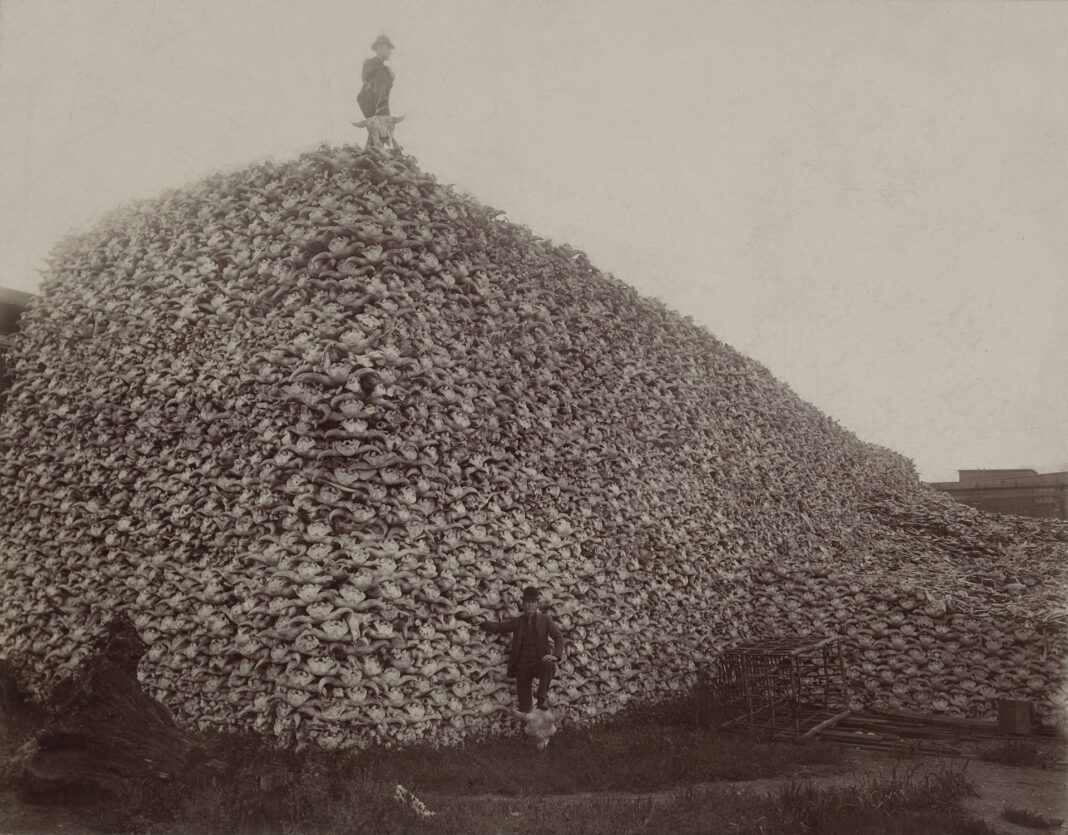It always amazes me what can be accomplished by consistently working at task every day. Every time I go over one of the many bridges that span the Willamette, I marvel at what humans can do. Hundreds of people working every day for months and viola, the Fremont Bridge. I remember watching the news as they raised the central span into place all those years ago. The local newsman asked what they would do if it was too small. I still marvel every time I cross the bridge.
Millions or billions of people consistently performing the same task every day does not always result in an Empire State building, an Eiffel Tower or a Great Pyramid. 1.5 billion cars driving every day? 4.6 metric tonnes CO2 added to the atmosphere per car per year. People tossing plastics? 400 million tonnes a year in the environment.
1.3 billion people use Traditional Chinese Pseudo-Medicine (TCPM) and other traditional pseudo-medicines (TPM). Many of the nostrums proffered by these traditions are plants and animal parts, a limited resource.
Over 11 000 herb plants have been recorded in various TCM-related pharmacopeia, and the commonly used ones are ∼700 species.
and
98 of 616 ingredients listed in the latest Pharmacopoeia are animal‐based , and 823 animal species are documented in the Medical Fauna of China as having been used or still in use with most being insects or other invertebrates.
Over a billion people using TPM are going to have an adverse impact of the plants and animals misused as medicine, all to no purpose. There are many traditional pseudo-medicines that misuse animals and plants in a fruitless attempt to treat illnesses.
I reviewed this aspect of TCPM all the way back in 2009. 2009? Gives one pause, where does the time go? But the release of a poor bear who spent 21 years in a bile farm cage suggested it might be time to produce an update the pointless cruelty and death at the heart of TCPM. To be honest, it is not all TCPM. The useless use of animals and plants is not limited to the Chinese and is a feature of many traditional medicines. Those in the west are also responsible for needless death and suffering, as some TCPM and adjacent pseudomedicines are popular.
And TPM is big money:
nearly two-fifths of the seizures of illegally trafficked wildlife products made in the EU were of a medicinal nature
Rhinoceros
Let us start with the poster boy. Poster-animal.
Yeah. Rhinos. Horn used as an aphrodisiac. Like eating fingernails is going to help your impotence. It is a bit of sympathetic magic that says something about those who partake. But I will not go there. Or there. As much as I want to.
Rhino horn is used for more than sexual dysfunction. I find nosebleeds, hangover cure, fevers and stroke prevention on the list of its alleged TCPM benefits. But not that I can find baldness, which is odd that the horn is mostly tightly packed keratin aka hair. In Vietnam rhino horn is touted as a cancer cure (NOT part of TCPM, where rhino horn is not used for cancer treatment). Since 2009 cancer treatment has only made it worse for rhinos. As of 2013
The country’s appetite for rhino horn is so great that it now fetches up to $100,000/kg, making it worth more than its weight in gold. (Horns average around 1-3 kg each, depending on the species.)
Rhino horn may be worth even more today.
A recent report puts the price of rhino horn in Asia at $60,000 per pound.
Although prices vary depending on the report and the year.
And who knows what tariffs will add to the cost of rhino horn imported into the US for the purpose of MAHA. Hahahahahahaha. At that price, it is not surprising that rhino poaching (illegal hunting, not cooking in boiling water) has increased since 2009, peaking in 2015 at about 1300 rhinos a year, now around 600 a year. Rhinos have enough problems surviving with habitat loss, poaching for a worthless cancer cure only makes a bad problem worse.
There have been suggestions that there needs to be a rhino horn substitute. Like, what? Besides, reality -based treatments? You might eat saccharin instead of sugar. Both are sweet, after all. But given that the benefits of rhino horns are imaginary, what could be offered as a substitute? Floor clippings from Supercuts? Why not? Technically the same product.
They are trying both dehorning and injecting horns with radioactive compounds to combat poaching, but given the demand and the money involved, I would not be optimistic for the future of the Rataxes’ family.
Tigers
Demand, and price, for tiger parts, especially bone, eyes, and penis, have increased.
In Taiwan, a bowl of tiger penis soup (to boost virility) goes for $320, and a pair of eyes (to fight epilepsy and malaria) for $170. Powdered tiger humerus bone (for treating ulcers rheumatism and typhoid) brings up to $1,450 lb. in Seoul.
And we complain about the price gouging of Big Pharma, At least most Pharma products are based on reality and are mostly effective. And don’t usually exterminate animals.
Since China has almost eradicated its own tiger population, it is now looking for a new supply of tigers from Bangladesh and Nepal. The World Wildlife Fund estimates that one-third of the breeding-age female tigers were lost between 1989 and 1991 in this area.
Computer models suggest even small amounts of tiger poaching have huge effects on limited populations:
The model predicts, If poachers killed 10 of the animals in a tiger group every year for three years, the group would have less than a 20 percent chance of extinction in the 75 years after poaching stopped. Destroying 15 tigers a year for 3 years, however, bumps the probability of extinction up to 50 percent. If poachers kill 15 tigers in a group each year for six years, or 10 animals for nine years, this will destroy the group.
At least conservation efforts have made some increase in tiger populations.
In 2010, the estimated number of wild tigers was approximately 3,200, a low point after a long period of decline. By 2022, the population had grown to an estimated 4,500 tigers, and by 2024, the latest estimate from the Global Tiger Forum placed the number at 5,574 wild tigers.
Which is nothing to the 8000 tigers estimated to be in tiger farmss, where they are being raised to be turned into worthless nostrums, like tiger bone wine at $257 per 500 ml (about 17 ounces). Sad end to a big cat.
Seahorses
Seahorses have been used by TCPM for 600 years and thought to be a natural Viagra. Huh? Why? If it is sympathetic magic like a rhino horn, the users have issues greater than impotence and premature ejaculation. I can’t find a good explanation for seahorses as ED medication besides seahorses as an energy enhancer. As an aside, it seems most products are used for ED of some sort, which doesn’t jibe with China’s population.
With
“37 million seahorses are caught in the wild every year.”
it is no wonder,
“populations of at least 11 species of seahorse have dropped by between 30 – 50%”
One would think that Viagra would help the seahorses. Save them for harvest I mean. Not aware that seahorses have ED. Nope.
Rather than diminish its appeal, however, Viagra appears to have spurred a huge increase in demand for impotence remedies using seahorses as a cheaper alternative to the western wonder drug.
Even when there is a drug that actually works, people prefer to wipe out animals instead.
Donkey
Donkey-hide gelatin, ejiao in Chinese, is made by boiling donkey skins, poaching in both meanings. I presume once the donkey has been removed.
It has been used in traditional Chinese medicine for thousands of years. Why donkey? Don’t know, although one review suggests it was because they ran out of cows and had a lot of extra donkey around. Tell that to Shrek. But
Since the Song Dynasty, most medical experts have agreed that donkey should be the raw material for ejiao
Which begs the question just who these medical experts are. Probably recently hired at the CDC and NIH, as I think about it.
Many of the articles suggest the product is beneficial in hematopoesis. I could not find much and it was almost all in rodents. How applicable 5-FU and γ-ray radiation induced anemic mice models are to human diseases is questionable. And virtually all studies started with the statement that ejiao is beneficial for anemia, and sought to find the reason. Yep, no bias there. Oh no.
The one human study in blood-deficient patients, a TCPM diagnosis that has NOTHING to do with anemia, found.
the hematocrit and red blood cell numbers decreased in the placebo control group, but decreased significantly less in the Ejiao treatment group.
So make of that as you will.
As with all TCPM, it is recommended for a hodgepodge of medical conditions, but not impotence. Or not.
“When a man takes ejiao, he will be strong and virile and have a long life. When a woman takes ejiao, she will keep her youth and become as beautiful as a princess.
Must be sold in a Disney movie where the princesses are always beautiful.
As China has run out of donkeys, they have shifted to African donkey sand the animal has not benefited from the attention.
China needs about 5 million donkeys a year to produce and meet the demand for ejiao, and about 2 million of these come from China’s own population of the animals. Of the remaining 3 million or more sourced abroad,
With some local populations dropping by 70%. It is an 8 billion dollar a year industry and hides go for around $800 a kilogram. Many donkeys are stolen from their owners who need the animals to help in farming. Can you say a donkey is a work-horse? Sounds wrong.
To make matters worse, in 10211 there was a popular Chinese TV drama, Empresses in the Palace, that
was all set in the (Chinese) imperial court and at a certain time of the day the ladies of the court would all say, ‘Let’s have some ejiao,’” said Pope. Ejiao, also called donkey glue, is used as medicine or as a tonic for health and beauty in China.
“As a result of this program the demand for ejiao just literally went through the roof.”
God forbid an internet influencer decides ejiao is a thing. It could the be the straw that broke the donkeys back.
So donkeys are being slaughtered at amazing rates to provide a worthless TCPM and it is only getting worse.
Pangolin
Pangolins are scaled anteaters, a mammal that has been used in TCPM for thousands of years. Especially the scales.
Fresh scales are never used, but dried scales are roasted, ashed, cooked in oil, butter, vinegar, boy’s urine, or roasted with earth or oyster-shells, to cure a variety of ills. Amongst these are excessive nervousness and hysterical crying in children, women possessed by devils and ogres, malarial fever and deafness.
Cooked in boy’s urine? Women possessed by devils and ogres? The things you find when going down the rat holes of TCPM. But that was in 1938; there is less promotion of the product for demon possession today. And it is well known that ogre are resistant to pangolin exorcism. Now the scales allegedly help blood flow and dissolve clot. Besides China, the scales are also used in other parts of Asia and in Africa, with the uses are variable depending on the part of the world. In Ghana
Pangolin scales and bones were the most prevalent prescribed body parts and indicated the highest cultural significance among traditional healing practices primarily for the treatment of spiritual protection, rheumatism, financial rituals and convulsions.
Probably used on Wall Street as well. It would explain a lot. Used for impotence as well. Of course.
And, as always, the various diseases treated have zero common pathophysiology.
Not unsurprisingly, for reality-based treatments, pangolin scales do nothing:
In conclusion, there is no reliable evidence for the clinical value of Squama Manitis.
Pangolin scales remain in high demand, it being the most highly trafficked mammal on the planet. I can’t tell if humans are on the list, but at a million poached over the last decade, it is tough being a pangolin:
All eight species of pangolin are assessed as threatened by the IUCN, while three are classified as critically endangered.
And all for nothing.
Saiga Antelope
In 2009 I wrote
These animals have been hunted for their horns, which are used to treat stroke, colds and high blood pressure, and, since rhino horn is both expensive and rare, a cheaper alternative to rhino horn. Because of the protection of the rhino combined with their tiny numbers, the practitioners of traditional Chinese medicine have had to find another species to decimate for useless medical therapy. As a result their numbers of Saiga have gone from 1 million to under 30,000 and falling.
The animal appeared to be following in the footsteps of his console cousins.
But no.
Saiga, once close to extinction with a population of only 48,000 in 2005, has experienced an extraordinary rebound in Kazakhstan.
Current estimates now surpass 1.9 million, showcasing a triumph attributable to nearly two decades of dedicated conservation work by governments, non-governmental organizations, research organizations, and the Service
So it is not all gloom and doom. Well, it is. Kazakhstan is experiencing severe impacts from global warming, with temperatures rising at a rate twice the global average and the country now ranked among the top ten most affected by climate change. Rather than being killed for their horns, they may get to succumb to consequences of climate change. Out of the frying pan, into the fire.
Humans
Yep. Humans. Extinction of humans is not an issue. Yet. But for albinos?
In the last decade, close to 200 killings and more than 500 attacks on people with albinism have been reported in 27 sub-Saharan African countries.
Tanzania has the highest number of recorded attacks globally at more than 170. There have also been reports of attacks in the Democratic Republic of Congo, Malawi, Mozambique and Burundi.
Most of these attacks are fueled by rising demand for the body parts of people with albinism used in rituals by traditional healers, known as muti killing or black magic, juju.
The hair and bones, genitals and thumbs of people with albinism are said to possess distinct powers. Alleged to bring wealth or success, they are often dried and ground, put into a package to be carried, to be secreted in boats, businesses, homes or clothing, or scattered in the sea.
What can one really say about something so awful and so wrong?
The above is but a sample of the impact traditional medicines have on wildlife, either by ‘harvesting’ wild animals or raising them in cages for useless consumption.
70 different wild animals used in traditional Chinese medicine listed in Pharmacopoeia. However, scientists have evidence of over 2,200 species being used.
and this doesn’t include the rest of the world. As to plants
723 species used as treatments are threatened with extinction.
It is mostly getting worse and all for naught.
I suppose the list will grow ever longer.
On the bright side…Can’t think of one.





